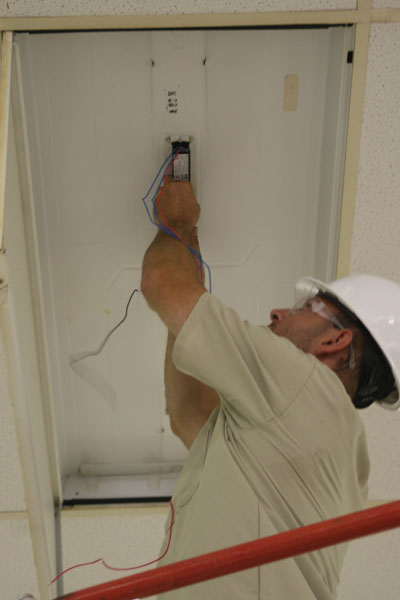The “right” people for the “right” job.
Have you ever heard the saying, “Do it right the first time?” What a simple — yet difficult — task. In the world of lighting maintenance it is inevitable that all lighting systems will experience performance failures during operation, therefore requiring maintenance to be conducted. Regular maintenance is necessary to guarantee that retail facilities receive the preferred quantity and quality of light, as well as energy efficiency from their lighting systems. Some businesses pay no attention to their lights until a lamp goes out; then they call the maintenance service company or fix it themselves. Then another lamp fails, they call the maintenance crew again, or back up the ladder they go. It is impossible to go on indefinitely like this, replacing the lamps as they fail. There are two maintenance repair options when a failure takes place: scheduled maintenance and reactive maintenance.
When a facility experiences a lamp failure, there are three people who could potentially fix the problem: in-store personnel, an in-house maintenance group or a service company. There are then two options of how the maintenance repair could take place. The facility manager could schedule repairs to be completed by a service company, or they could use their in-house personnel to repair the problem when the issue arises. When a facility experiences a ballast failure, either the in-house maintenance group or a service company would be capable of solving the issue.
In many retail facilities, lighting systems are maintained in a reactive manner — meaning that lamps or ballasts are replaced only when they fail. Some facilities have begun to schedule regular maintenance appointments as a way to save money and ensure that a consistent store image is being upheld for its customers.
 Scheduled (or planned) lighting maintenance organizes labor and resources to ensure reliable, recommended light levels and the most economical use of a lighting system. Scheduled maintenance can also produce a variety of benefits, including a cleaner, brighter workplace, enhanced productivity and in-store merchandise, as well as a more secure environment. Data shows that planned maintenance strategies can reduce labor and trip/travel costs up to 50%. It can produce higher light levels over the lifespan of the lighting system as well as reduce energy costs and consumption. Another important advantage of planned maintenance is that it allows companies to budget a fixed amount of expenses.
Scheduled (or planned) lighting maintenance organizes labor and resources to ensure reliable, recommended light levels and the most economical use of a lighting system. Scheduled maintenance can also produce a variety of benefits, including a cleaner, brighter workplace, enhanced productivity and in-store merchandise, as well as a more secure environment. Data shows that planned maintenance strategies can reduce labor and trip/travel costs up to 50%. It can produce higher light levels over the lifespan of the lighting system as well as reduce energy costs and consumption. Another important advantage of planned maintenance is that it allows companies to budget a fixed amount of expenses.
The second option is reactive maintenance. This is when an in-store sales or maintenance person performs the troubleshooting on their own. For example, if a light is out, that employee will climb the ladder and replace the lamp, given that the inventory is in stock and readily available. However, a salesperson was hired to do sales — not repair lighting — in the store.
There are numerous disadvantages associated with self-maintenance. The most significant disadvantages are that the person who repairs the light may not be qualified to do so; the cost of maintaining inventory; and the risk of injury. Sure, it is low cost and speedy, but if an in-store salesperson is asked to get up on the ladder and change a lamp, there are a number of issues that could arise. What if they put the lamp in incorrectly? What if they install the wrong lamp? What if they fall? This “quick, easy fix” just cost the store time, product, money and more harm than good.
The benefits of quality lighting are easy to see: reduced operating costs, increased productivity, and an improved image. Take a closer look and the benefits of a good lighting maintenance program are even easier to see. You will have maximized operating efficiency and assurance that the lighting will be serviced and installed correctly. This will also allow store personnel to focus on a sale — which is most important in retail.
When considering which maintenance repair plan is right for your store, it is important to weigh the options along with the advantages and disadvantages. Now that you have seen the advantages and disadvantages of both maintenance repair options, you are probably leaning toward a scheduled maintenance repair, right? It seems like an easy choice. A regular maintenance schedule not only keeps your light output at optimal levels, but keeps your system working at peak energy efficiency. With this in mind, many facility managers are now adopting this scheduled maintenance program for these reasons.
— Lou DiDomenico is the vice president of operations of Action Services Group, based in Aston, Pennsylvania.
